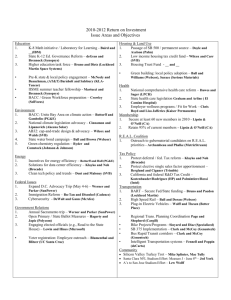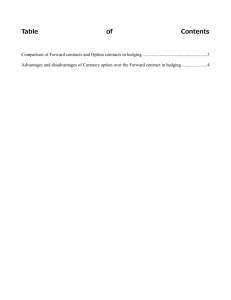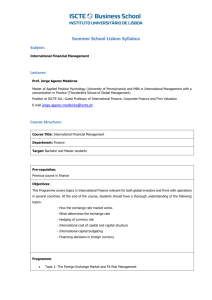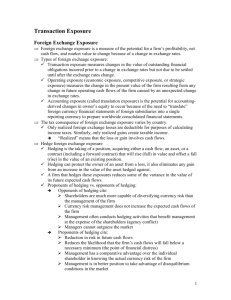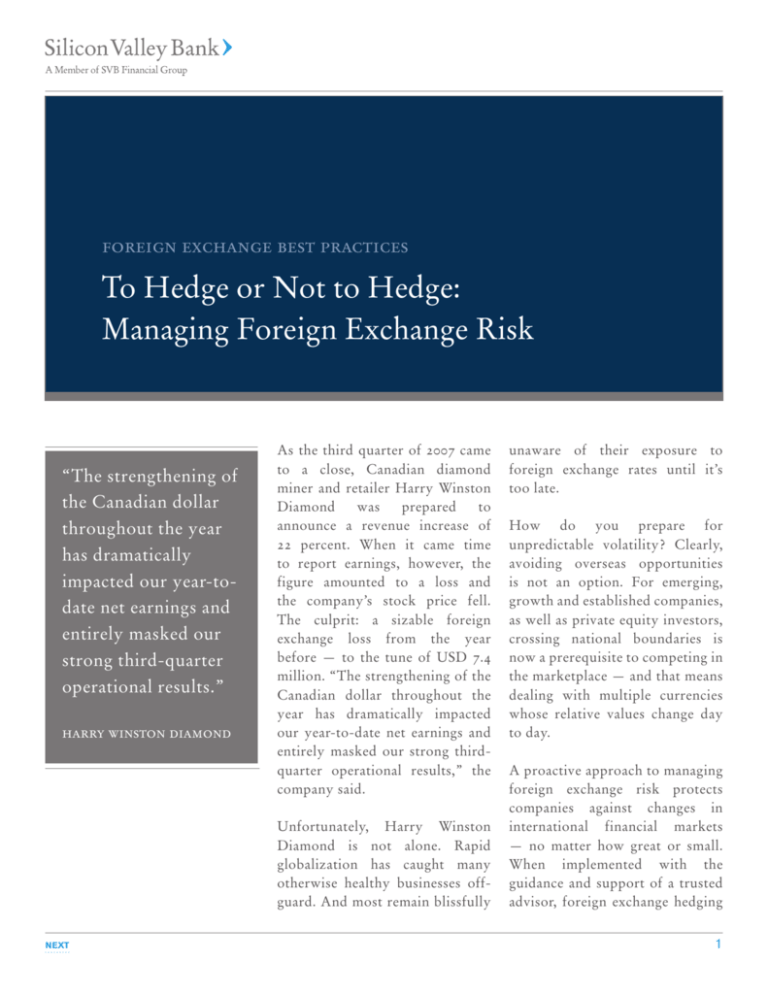
foreign exchange best practices
To Hedge or Not to Hedge:
Managing Foreign Exchange Risk
“The strengthening of
the Canadian dollar
throughout the year
has dramatically
impacted our year-todate net earnings and
entirely masked our
strong third-quarter
operational results.”
harry winston diamond
As the third quarter of 2007 came
to a close, Canadian diamond
miner and retailer Harry Winston
Diamond
was
prepared
to
announce a revenue increase of
22 percent. When it came time
to report earnings, however, the
figure amounted to a loss and
the company’s stock price fell.
The culprit: a sizable foreign
exchange loss from the year
before — to the tune of USD 7.4
million. “The strengthening of the
Canadian dollar throughout the
year has dramatically impacted
our year-to-date net earnings and
entirely masked our strong thirdquarter operational results,” the
company said.
Unfortunately, Harry Winston
Diamond is not alone. Rapid
globalization has caught many
otherwise healthy businesses offguard. And most remain blissfully
NEXT
unaware of their exposure to
foreign exchange rates until it’s
too late.
How do you prepare for
unpredictable volatility? Clearly,
avoiding overseas opportunities
is not an option. For emerging,
growth and established companies,
as well as private equity investors,
crossing national boundaries is
now a prerequisite to competing in
the marketplace — and that means
dealing with multiple currencies
whose relative values change day
to day.
A proactive approach to managing
foreign exchange risk protects
companies against changes in
international financial markets
— no matter how great or small.
When implemented with the
guidance and support of a trusted
advisor, foreign exchange hedging
1
Foreign Exchange Best Practices
To Hedge or Not to Hedge: Managing Foreign Exchange Risk
strategies offer a viable solution.
Throughout the high-tech and life
sciences industries, savvy CFOs
and prudent boards are implementing these innovative financial
tools to safeguard overseas cash
flows and investments.
THE HEART OF THE MATTER
Foreign exchange risk affects
companies in myriad ways:
through overseas transactions,
the conversion of one currency to
another on the balance sheet, or
changes in a company’s competitive
position in the market. Whatever
the source, the consequences can
be far-reaching, wiping out profits
and straining relationships with
partners and customers.
Consider the case of one global
provider of electronic payment
solutions with operations in the
United States, Brazil, China,
Hungary, Mexico and the United
Kingdom. It reported revenues
of USD 260 million in 2002 with
operating income of USD 1.6
million, but experienced a material
foreign exchange loss of USD
6.0 million and could not explain
why.* Foreign exchange exposure
“It’s not enough to
hope the market moves
in your favor.”
PREVIOUS
NEXT
Sources Of Foreign
Exchange Risk
Every international transaction
across
national
boundaries exposes either
the importer or the exporter
to foreign exchange risk.
There are several common
sources:
• Overseas sales operations
• Manufacturing facilities
• Outsourced development
or support
• Customer relationships
• Supplier relationships
• Balance sheet conversions
• Changing competitive
position in the economy
turned out to be the cause. Similarly, Angiotech Pharmaceutical
attributed a USD 7.8 million loss
in the third quarter of 2007 to the
rise in the Canadian dollar against
the U.S. dollar.
How will a 10 percent swing
in foreign exchange rates affect
your earnings? How about
100 percent?
Recall the Asian currency crisis
of 1997-98, when the Korean
Won lost 54 percent of its value
in two months during November
and December in 1997. Or reflect
on the dramatic fall of the dollar
against the euro in 2007. From the
subprime mortgage crisis and the
possibility of a U.S. recession to
the strength of emerging markets,
financial disruptions are making
news headlines on a daily basis.
With economic growth and interest rates in question, management
teams need to plan for an
uncertain future.
NO ZERO-SUM GAME
Yet, despite the growing case for
hedging, even the most experienced
CFOs often hesitate to recommend
a foreign exchange strategy to
their boards.
•Some believe hedging is a form
of speculation.
In the case of foreign exchange,
it is not. Hedging actually
reduces risk by revealing
the underlying expense or
revenue.
•Others believe they are immune
because they price and report in
dollars.
They are not. Anytime a
cross-border transaction takes
place, one party inherits the
foreign exchange risk.
•Still others assume that foreign
exchange movements even out
over time.
They do not. The Canadian
dollar is at levels last seen when
Jimmy Carter was President.
It’s not enough to hope the market
2
Foreign Exchange Best Practices
To Hedge or Not to Hedge: Managing Foreign Exchange Risk
Is Foreign Exchange Hedging Right For Your Business?
Answer these questions to determine if your company should
implement a foreign exchange hedging policy:
• Does your company generate revenue in other currencies?
• Do you need to fund an overseas office and/or subsidiaries?
• Do you have overseas suppliers, vendors, consultants
or contractors?
• Do you expense costs in one currency and report associated
revenue in another currency?
moves in your favor. You need to
do the analysis.
The right mix of hedging products
— from spot contracts and currency
swaps to over-the-counter options
— can minimize the probability of
a business disruption by offsetting
the exposure of hedged items.
As the Federal Reserve Bank
recently
observed,
“Strongly
governed companies use currency
derivatives more when the degree
of currency exposure, expected
financial distress costs and growth
opportunities are higher.”
MORE THAN MITIGATING RISK
When implemented responsibly,
a successful foreign exchange
hedging strategy can go beyond
mitigating foreign exchange risk
to actually improving the bottom
line. For example, some companies
use leading and lagging as hedging
tools. Companies are able to
PREVIOUS
NEXT
accelerate receivables to improve
their cash positions, while saving
money on goods purchased abroad
by postponing payments.
Leading
• Accelerate payment of
strengthening currencies
• Speed up receipt of
weakening currencies
Lagging
• Delay payment of
weakening currencies
• Postpone receipt of
strengthening currencies
Hedging a benchmark exchange
rate can be a valuable tool for an
overseas sales force by removing
foreign exchange risk from the
pricing equation and allowing
the company to negotiate from a
more competitive position when
bidding for overseas contracts.
For public companies, hedging
creates shareholder value by
increasing earnings predictability.
Simply put, foreign exchange
hedging helps companies compete
more effectively in an increasingly
global market.
Consider the case of one SVB
client, a manufacturer of cleantech
equipment that signed a contract
with a supplier based in Germany.
The contract was valued at EUR
22.8 million, payable over 12
months. Based on the client’s
foreign exchange policy, which
called for the company to hedge
all known foreign exchange
exposures, the company entered
into a series of forward contracts
that extended out one year and
matched its scheduled A/P payments.
The euros were purchased through
forward contracts and priced from
1.35-1.37.
At the end of the year, the company had met its primary objective:
“A foreign exchange
hedging strategy
minimizes the
probability of a
business disruption
by offsetting the
exposure of hedged
items.”
3
Foreign Exchange Best Practices
To Hedge or Not to Hedge: Managing Foreign Exchange Risk
the euro-denominated cash flow
had a fixed U.S. dollar cost, based
on the forward foreign exchange
rates, and the foreign exchange risk
was removed. In addition, the euro
strengthened during the same time
period, saving the client up to 7.5
percent based on the difference of
the locked-in rate and the exchange
rates on the day.
GETTING IT RIGHT
Although putting a hedging
strategy in place is less complicated than many CFOs expect,
there’s more to it than simply
calling up your neighborhood
trader. A diligent company
will follow these six steps to
get started:
1. Collect data about your
business to develop a clear
picture of your foreign exchange
exposure. Review transactions
with overseas contractors, vendors and customers, as well as
foreign currency invoices and
monthly transfers.
2. Determine the ways in which
foreign exchange hedging can
benefit your current and future
business plans.
3. Plan how you might work with
a trusted foreign exchange advisor
to set up a hedging strategy and
monitor its risks and results.
4. Establish a foreign exchange
“policies and procedures” document to formalize your strategy
— and do this as you begin to
expand the business, rather than
after the fact.
5. Select the right financial
tools for your business — and
don’t overlook internal hedging
strategies such as matching
exposure, sourcing, production
and leading and lagging.
Elements of a Foreign
Exchange Policy
•
•
•
•
Objectives
Responsibilities
Controls
Strategies
Foreign Exchange Hedging Products
Spot trades: These contracts are typically used for immediate delivery of foreign currency payments or
converting foreign currency receipts into U.S. dollars at prevailing market rates.
Forward contracts and forward window contracts: These contracts are used to lock in exchange
rates for a specific future date, or for a range of dates. Forward contracts are often used as a tool to
eliminate the impact of adverse currency movements and protect profit margins by determining a forward
rate for the exchange.
Currency swaps: A currency swap is a foreign exchange agreement between two parties to exchange
a given amount of one currency for another, and after a specified period of time to give back the original
amounts swapped. Swaps are an effective tool to manage time difference of foreign currency cash flows.
Currency options: By paying an upfront premium, over-the-counter option contracts provide the right to
buy or sell a foreign currency at a predetermined rate (strike price) at a specific time frame in the future.
Options are particularly useful when you need to hedge an uncertain or contingent exposure, such as
one that involves tendering for a contract.
PREVIOUS
NEXT
4
Foreign Exchange Best Practices
To Hedge or Not to Hedge: Managing Foreign Exchange Risk
6. Work closely with your
accountants, senior management
and other finance team members to
ensure that the strategy you select
is appropriate for your company,
especially because different hedging products have different costbenefit profiles. Make sure the
cost you paid for the strategy
will match your company’s riskreward objective in your foreign
exchange policy.
When it comes to foreign exchange
hedging, choosing a financial
services provider may be the most
important decision you’ll make.
Not all banks are created equal,
so it pays to do some research.
Consider these criteria when
evaluating potential providers:
Pre-trade advisory
Will you have direct access to
experienced traders? If so, how
much time do traders have to spend
with clients? A personalized and
consultative approach is essential
to a solutions-driven strategy.
Depth of the trading floor and
staffing experience
How well does your trader
know your business, and does
your financial services provider
have a specialized focus in
your industry? Does the trader
have prior experience with
major banks and trading the
foreign exchange products that
are offered?
PREVIOUS
NEXT
Credit limits
How flexible is the financial services
provider in its requirements?
Execution and responsiveness
Does your financial services
provider trade in all liquid
currencies? How easily can you
get a live executable quote?
environment. Accordingly, prudent boards need to plan for
volatility, and responsible CFOs
must bring viable foreign exchange
solutions to their management.
Don’t let foreign exchange
exposure be the reason you don’t
make your numbers.
Post-trade follow-up
Will you receive your purchased
currency on time? How fast will
your financial services provider
correct settlement problems? How
easy is it to get information on
transaction history and outstanding
trades? Will you be able to see a
mark-to-market report regularly?
Foreign exchange hedging advisory should come in the form of
a bundled package of customer
services addressing every step in
the process, from pre-trade to
execution to post-trade follow-up.
By applying a deep understanding
of foreign exchange markets and
the forces that drive them, your
financial services partner can make
recommendations with your best
interests in mind. A good advisor
will support your existing foreign
exchange strategy, help you set up
a formal policy, or simply begin
with a thorough review of your
business to assess its exposure to
foreign exchange risk.
Foreign exchange risk is a reality in today’s global business
5
Foreign Exchange Best Practices
To Hedge or Not to Hedge: Managing Foreign Exchange Risk
About SVB Financial Group
For 25 years, SVB Financial Group and its subsidiaries,
including SVB Silicon Valley Bank, has been dedicated to helping
entrepreneurs succeed. SVB Financial Group is a financial holding
company that serves emerging growth and mature companies in
the technology, life science, private equity and premium wine
industries. Offering diversified financial services through SVB
Silicon Valley Bank, SVB Analytics, SVB Capital, SVB Global
and SVB Private Client Services, SVB Financial Group provides
clients with commercial, investment, international and private
banking services. The company also offers funds management,
broker-dealer transactions, asset management and a full range of
services for private equity companies, as well as the added value of
its knowledge and networks worldwide. Headquartered in Santa
Clara, Calif., SVB Financial Group operates through 27 offices
in the U.S. and three internationally. More information on the
company can be found at www.svb.com.
For more information on hedging or any of our foreign exchange
services, please contact:
SVB Silicon Valley Bank
Foreign Exchange Desk
3003 Tasman Drive Santa Clara, California 95054
phone 888.313.4029 e-mail FXTraders@svb.com
*
Fireapps, Case Studies; http://www.fireapps.com/CaseStudies/CaseStudy2.asp
PREVIOUS
NEXT
6
headquarters
3003 Tasman Drive Santa Clara, California 95054 U.S.A.
phone 408.654.7400 svb.com
Foreign exchange transactions can be highly risky, and losses may occur in short periods of time if there is an adverse movement of exchange rates.
Exchange rates can be highly volatile and are impacted by numerous economic, political and social factors, as well as supply and demand and governmental
intervention, control and adjustments. Investments in financial instruments carry significant risk, including the possible loss of the principal amount
invested. Before entering any foreign exchange transaction, you should obtain advice from your own tax, financial, legal and other advisors, and only
make investment decisions on the basis of your own objectives, experience and resources. Opinions expressed are our opinions as of the date of this
content only. The material is based upon information which we consider reliable, but we do not represent that it is accurate or complete, and it should
not be relied upon as such.
© 2008 SVB Financial Group.SM Member Federal Reserve. All rights reserved. SVB, SVB> and SVB>Find a way are all service marks of SVB Financial Group.
SVB Silicon Valley Bank refers to Silicon Valley Bank, the California bank subsidiary of SVB Financial Group. Silicon Valley Bank is a registered trademark of
SVB Financial Group. SVB Silicon Valley Bank Member Federal Reserve and FDIC. Rev. 06-25-08.

